Blank Basketball Evaluation PDF Form
The Basketball Evaluation Form is a tool designed to assess a player's skills and performance in various aspects of the game. It provides evaluators with a structured way to rate players on shooting, defense, dribbling, and more, ensuring a comprehensive review of their abilities. By filling out this form, coaches can offer valuable feedback and recommendations for player development.
Ready to evaluate your skills? Click the button below to fill out the form!
Access Editor
